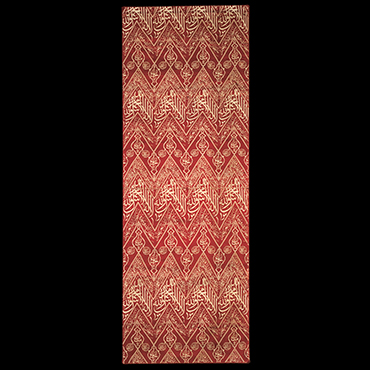The Inner Sactuary
These two kiswah panels once adorned the interior walls and pillars of the Ka‘bah. Unlike the exterior kiswah of the Ka‘bah, which was previously produced in Egypt and sent annually with the Hajj caravan, kiswahs made for the Ka‘bah’s interior were renewed periodically, at times upon the accession
of a new ruler.
From at least the 10th century AH/16th century CE, a kiswah was sent not only for the interior walls of the Ka‘bah but also for the three pillars in the center of the building, which an Ottoman register issued early in the reign of Selim II (r. AH 974–982/1566–74 CE) names as: “Hannan (O Merciful!),
Mannan (O Benefactor!), and Dayyan (O Recompenser).” Significantly, kiswahs for the Ka‘bah’s interior dating from at least the 12th century AH/18th century CE—including the piece displayed in AlBidayah—featured the first two of these names.
Whilst 10th-century AH/16th-century CE examples closely resembled the exterior kiswah in terms of both weaving patterns and inscriptions, the interior kiswah took on its own character over the next four centuries. Like the kiswah on display, they featured a characteristic zigzag or chevron pattern in cream or yellow on a red background. The piece displayed in AlBidayah also has a narrow band of calligraphy featuring a verse from the Holy Qur’an, chapter Al-Baqarah (2:144), which commands believers to turn towards the Ka‘bah as the new direction of prayer (qiblah).
Interior textiles of the Ka‘bah
Likely Bursa, Türkiye
12th–13th century AH/18th–19 century CE
Silk-satin, lampas weave, h. 189.5 × w. 67.3 cm
National Museum of Asian Art, S1996.62.1

